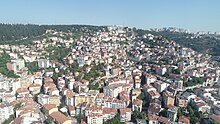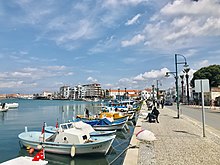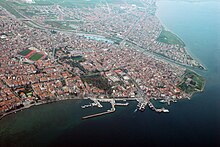Marmara Region
Marmara
Marmara Bölgesi | |
|---|---|
 | |
| Coordinates: 41°00′N 29°00′E / 41.000°N 29.000°E | |
| Country | Turkey |
| Capital | Istanbul |
| Provinces | |
| Area | |
| • Total | 67,000 km2 (26,000 sq mi) |
| • Rank | 6th |
| Population (Jan. 2022)(INSEE) | |
| • Total | 27,050,405 |
| • Rank | 1st |
| • Density | 400/km2 (1,000/sq mi) |
| Demonym | Turkish: Marmaralı |
| GDP | |
| • Total | US$ 367.040 billion (2022) |
| • Per capita | US$ 13,569 (2022) |
| Time zone | UTC+03:00 (TRT) |
| • Summer (DST) | UTC+03:00 (TRT) |
| ISO 3166 code | TR-IDF |
| NUTS Region | TR1 |
| Website | marmara |
The Marmara Region (Turkish: Marmara Bölgesi) is a geographical region of Turkey.
Located in East Thrace, it is bordered by Greece and the Aegean Sea to the west, Bulgaria and the Black Sea to the north, the Black Sea Region to the east, and the Aegean Region to the south. At the center of the region is the Sea of Marmara, which gives the region its name. The largest city in the region is Istanbul. Other big cities are Bursa, İzmit, Balıkesir, Tekirdağ, Çanakkale and Edirne.
Among the seven geographical regions, the Marmara Region has the second-smallest area, yet the largest population; it is the most densely populated region in the country.
Etymology
[edit]The name of the region comes from the Marmara Sea which is named after the Marmaros island, now connected to Balıkesir. "Marmaros" means "marble" in Greek. This name was given to the island because of the significant amount of marble found there. Over time, this name also came to be used for the sea itself.
The Greeks named the Marmara Sea "Propontis" by combining two words: "pro" and "pontis". In Greek, "pro" means "before" and "pontis" means "sea." They chose this name because they used to sail on the Sea of Marmara to reach the Black Sea.[2]





Subdivision
[edit]- Çatalca - Kocaeli Section (Turkish: Çatalca - Kocaeli Bölümü)
- Ergene Section (Turkish: Ergene Yöresi)
- Southern Marmara Section (Turkish: Güney Marmara Bölümü)
- Yıldız Section (Turkish: Yıldız Bölümü)
Ecoregions
[edit]Terrestrial
[edit]- Aegean and Western Turkey sclerophyllous and mixed forests
- Anatolian conifer and deciduous mixed forests
Provinces
[edit]Provinces that are entirely in the Marmara Region:
Provinces that are mostly in the Marmara Region:
Geography
[edit]The Yıldız Mountains and Uludağ are in the Marmara Region. Islands in the Aegean Sea are Gökçeada and Bozcaada, and in the Sea of Marmara are Marmara Island, Avşa, Paşalimanı, İmralı and the Princes' Islands of Istanbul.
Climate
[edit]The Marmara region has a borderline Mediterranean and humid subtropical climate on the Aegean Sea and south Marmara Sea coasts, and an oceanic climate on the Black Sea coast. Summers are warm to hot and moderately dry whereas winters are cool, wet and sometimes snowy. The coastal climate keeps the temperatures relatively mild.
See also
[edit]- East Thrace
- Sea of Marmara
- Dardanelles
- Bosporus
- Turkish Straits
- Geographical regions of Turkey
- Provinces of Turkey
References
[edit]- ^ "Statistics by Theme > National Accounts > Regional Accounts". www.turkstat.gov.tr. Retrieved 11 May 2023.
- ^ "The Importance of the Marmara Sea and Region for Turkey - Istanbul Property". istanbulproperty.com. Retrieved 2023-11-09.
External links
[edit]- Golyaka Village, Bursa (in Turkish)
Text is available under the CC BY-SA 4.0 license; additional terms may apply.
Images, videos and audio are available under their respective licenses.








